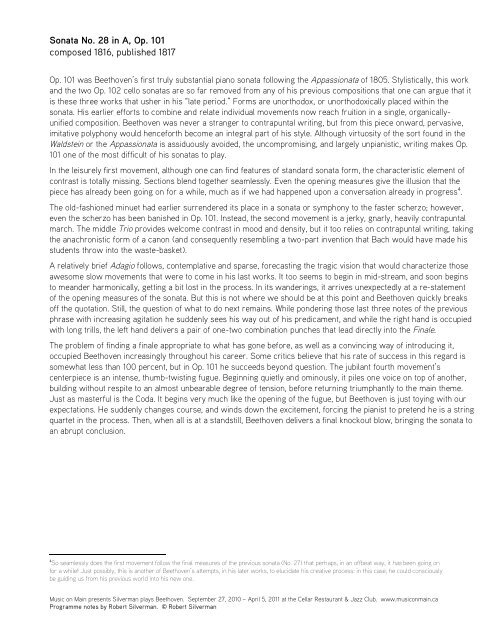beethoven's 32 piano sonatas robert silverman - Music on Main
beethoven's 32 piano sonatas robert silverman - Music on Main
beethoven's 32 piano sonatas robert silverman - Music on Main
You also want an ePaper? Increase the reach of your titles
YUMPU automatically turns print PDFs into web optimized ePapers that Google loves.
S<strong>on</strong>ata No. 28 in A, Op. 101<br />
composed 1816, published 1817<br />
Op. 101 was Beethoven’s first truly substantial <str<strong>on</strong>g>piano</str<strong>on</strong>g> s<strong>on</strong>ata following the Appassi<strong>on</strong>ata of 1805. Stylistically, this work<br />
and the two Op. 102 cello <str<strong>on</strong>g>s<strong>on</strong>atas</str<strong>on</strong>g> are so far removed from any of his previous compositi<strong>on</strong>s that <strong>on</strong>e can argue that it<br />
is these three works that usher in his “late period.” Forms are unorthodox, or unorthodoxically placed within the<br />
s<strong>on</strong>ata. His earlier efforts to combine and relate individual movements now reach fruiti<strong>on</strong> in a single, organicallyunified<br />
compositi<strong>on</strong>. Beethoven was never a stranger to c<strong>on</strong>trapuntal writing, but from this piece <strong>on</strong>ward, pervasive,<br />
imitative polyph<strong>on</strong>y would henceforth become an integral part of his style. Although virtuosity of the sort found in the<br />
Waldstein or the Appassi<strong>on</strong>ata is assiduously avoided, the uncompromising, and largely unpianistic, writing makes Op.<br />
101 <strong>on</strong>e of the most difficult of his <str<strong>on</strong>g>s<strong>on</strong>atas</str<strong>on</strong>g> to play.<br />
In the leisurely first movement, although <strong>on</strong>e can find features of standard s<strong>on</strong>ata form, the characteristic element of<br />
c<strong>on</strong>trast is totally missing. Secti<strong>on</strong>s blend together seamlessly. Even the opening measures give the illusi<strong>on</strong> that the<br />
piece has already been going <strong>on</strong> for a while, much as if we had happened up<strong>on</strong> a c<strong>on</strong>versati<strong>on</strong> already in progress 4 .<br />
The old-fashi<strong>on</strong>ed minuet had earlier surrendered its place in a s<strong>on</strong>ata or symph<strong>on</strong>y to the faster scherzo; however,<br />
even the scherzo has been banished in Op. 101. Instead, the sec<strong>on</strong>d movement is a jerky, gnarly, heavily c<strong>on</strong>trapuntal<br />
march. The middle Trio provides welcome c<strong>on</strong>trast in mood and density, but it too relies <strong>on</strong> c<strong>on</strong>trapuntal writing, taking<br />
the anachr<strong>on</strong>istic form of a can<strong>on</strong> (and c<strong>on</strong>sequently resembling a two-part inventi<strong>on</strong> that Bach would have made his<br />
students throw into the waste-basket).<br />
A relatively brief Adagio follows, c<strong>on</strong>templative and sparse, forecasting the tragic visi<strong>on</strong> that would characterize those<br />
awesome slow movements that were to come in his last works. It too seems to begin in mid-stream, and so<strong>on</strong> begins<br />
to meander harm<strong>on</strong>ically, getting a bit lost in the process. In its wanderings, it arrives unexpectedly at a re-statement<br />
of the opening measures of the s<strong>on</strong>ata. But this is not where we should be at this point and Beethoven quickly breaks<br />
off the quotati<strong>on</strong>. Still, the questi<strong>on</strong> of what to do next remains. While p<strong>on</strong>dering those last three notes of the previous<br />
phrase with increasing agitati<strong>on</strong> he suddenly sees his way out of his predicament, and while the right hand is occupied<br />
with l<strong>on</strong>g trills, the left hand delivers a pair of <strong>on</strong>e-two combinati<strong>on</strong> punches that lead directly into the Finale.<br />
The problem of finding a finale appropriate to what has g<strong>on</strong>e before, as well as a c<strong>on</strong>vincing way of introducing it,<br />
occupied Beethoven increasingly throughout his career. Some critics believe that his rate of success in this regard is<br />
somewhat less than 100 percent, but in Op. 101 he succeeds bey<strong>on</strong>d questi<strong>on</strong>. The jubilant fourth movement’s<br />
centerpiece is an intense, thumb-twisting fugue. Beginning quietly and ominously, it piles <strong>on</strong>e voice <strong>on</strong> top of another,<br />
building without respite to an almost unbearable degree of tensi<strong>on</strong>, before returning triumphantly to the main theme.<br />
Just as masterful is the Coda. It begins very much like the opening of the fugue, but Beethoven is just toying with our<br />
expectati<strong>on</strong>s. He suddenly changes course, and winds down the excitement, forcing the pianist to pretend he is a string<br />
quartet in the process. Then, when all is at a standstill, Beethoven delivers a final knockout blow, bringing the s<strong>on</strong>ata to<br />
an abrupt c<strong>on</strong>clusi<strong>on</strong>.<br />
4 So seamlessly does the first movement follow the final measures of the previous s<strong>on</strong>ata (No. 27) that perhaps, in an offbeat way, it has been going <strong>on</strong><br />
for a while! Just possibly, this is another of Beethoven’s attempts, in his later works, to elucidate his creative process: in this case, he could c<strong>on</strong>sciously<br />
be guiding us from his previous world into his new <strong>on</strong>e.<br />
<str<strong>on</strong>g>Music</str<strong>on</strong>g> <strong>on</strong> <strong>Main</strong> presents Silverman plays Beethoven. September 27, 2010 – April 5, 2011 at the Cellar Restaurant & Jazz Club. www.music<strong>on</strong>main.ca<br />
Programme notes by Robert Silverman. © Robert Silverman


